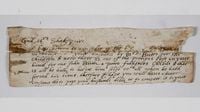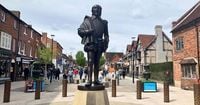In a remarkable twist to the narrative surrounding William Shakespeare's personal life, new research suggests that his marriage to Anne Hathaway may have been more harmonious than previously thought. This fresh perspective arises from a fragment of a 17th-century letter, which was recently analyzed and published in the journal Shakespeare by Professor Matthew Steggle of the University of Bristol. The letter, discovered in 1978, offers intriguing insights into the couple's life together and challenges long-held assumptions about their relationship.
Shakespeare married Anne Hathaway in 1582 when he was just 18 years old, and she was about 26 and pregnant with their first child. The couple went on to have three children: Susanna, and twins Hamnet and Judith. For over two centuries, it has been widely believed that Shakespeare left his wife and children in Stratford-upon-Avon while he pursued his career in London. This narrative has been popularized in various forms, including Maggie O'Farrell's 2020 novel Hamnet, which portrays a troubled relationship between the playwright and his wife.
The newly examined letter, which was fortuitously preserved within the binding of a book at Hereford Cathedral Library, suggests that the Shakespeares may have lived together in London at some point between 1600 and 1610. This is the first written evidence to support the idea that Anne was not merely left behind but was involved in her husband's life during his time in the city.
According to the letter, Shakespeare was allegedly withholding money from an apprentice named John Butts. The author of the letter reaches out to “Good Mrs Shakspaire” for assistance, indicating Anne's active role in financial matters related to her husband. Professor Steggle described the findings as a "game-changer in terms of thinking about the Shakespeares' marriage," noting that it casts new light on Anne Hathaway's involvement in William's social networks and financial affairs.
The letter also provides an address for Shakespeare on Trinity Lane in central London, a detail previously unknown to scholars. This new information raises questions about the traditional portrayal of Shakespeare's life as one where he was a distant figure, leaving his wife behind while he enjoyed the bustling life of a playwright. Instead, it suggests a different scenario, one where the couple shared their lives in the city, with Anne participating in William's endeavors.
Professor Steggle, who presented his findings on April 24, 2025, just a day after Shakespeare's 461st birthday, emphasized that the letter's significance lies not only in its content but also in its historical context. The fragments were initially dismissed as unimportant when discovered by librarian F.C. Morgan, who was over a century old at the time. However, Steggle's modern analysis has revealed the potential for new discoveries within 17th-century manuscripts, particularly those that may still be hidden in book bindings.
Reflecting on the implications of the letter, Steggle noted, "There’s this prevailing narrative that the Shakespeares’ marriage was very much an arms-length affair… This suggests an alternative scenario in which they are living together, at least a bit, in London, with Anne involved in William’s social networks and financial affairs." This perspective challenges the commonly held belief that Anne was merely a sidelined figure in Shakespeare's life.
The back of the letter fragment also contains what could be the first-ever recorded words from Anne Hathaway, further enriching the narrative of her life and contributions. The letter's existence and its content prompt a reassessment of the Shakespeare family, particularly the roles of women in his life, which have often been overlooked or trivialized.
Additionally, this discovery opens the door to further research into Shakespeare's life and the lives of those around him. Steggle expressed his hope that this finding would inspire scholars to search for more documents and scraps that could shed light on the playwright's personal history. He remarked, "It makes one passionately curious about other books, printed like this one by Shakespeare’s associate Richard Field, which might still be in their original bindings."
The narrative that Shakespeare left his family behind in Stratford has been a staple of biographical accounts, painting a picture of a man who prioritized his career over his familial obligations. However, these new findings suggest that the reality may have been more complex. The couple's potential cohabitation in London during a significant period of Shakespeare's career, when he was writing masterpieces like Hamlet and Twelfth Night, adds depth to their relationship.
Moreover, the letter's content raises questions about the nature of Shakespeare's legacy and how it has been shaped by historical interpretations. The notion that he left his wife a mere “second best bed” in his will has long been debated as either a loving gesture or a slight. With this new evidence, scholars may need to reconsider the dynamics of their marriage and the extent of Anne's influence on Shakespeare's life.
In conclusion, the fragment of the letter found in Hereford Cathedral Library not only provides a glimpse into the Shakespeares' marriage but also encourages a broader reevaluation of the roles that women played in the lives of historical figures. As research continues, it is likely that more insights will emerge, challenging established narratives and enriching our understanding of one of history's most celebrated playwrights.





